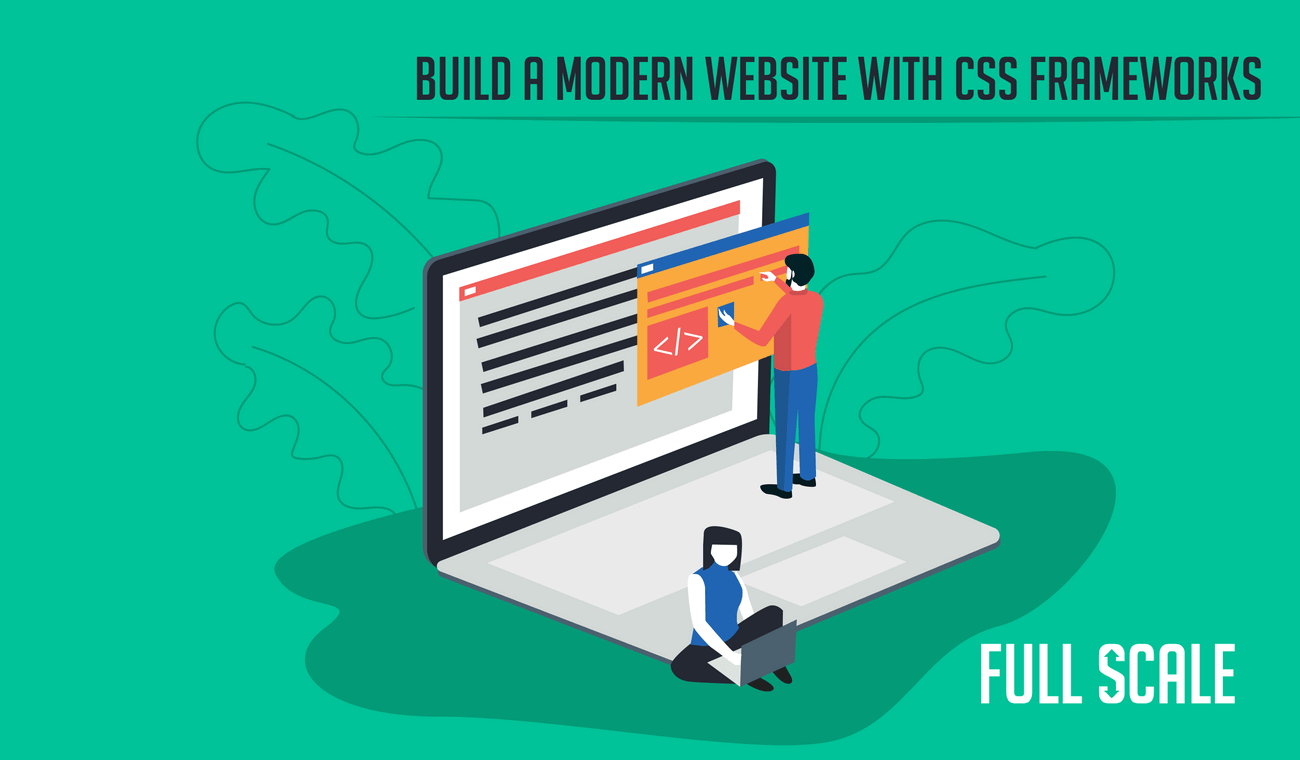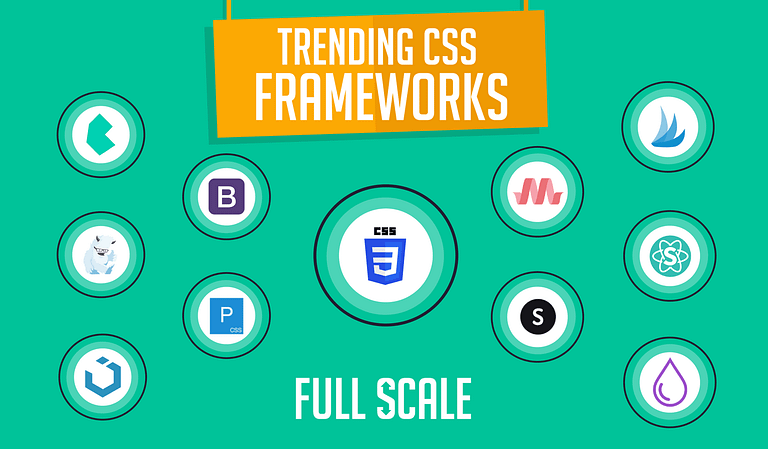Last Updated on 2025-02-20
Updated on December 27, 2023
Ever wondered which CSS frameworks can help you build a responsive website with minimal investment? Here is an overview of the top-performing frameworks.
Designing a website requires three things: time efficiency, responsiveness, and browser compatibility. This takes a lot of effort. Thanks to CSS frameworks, it removes the burden and fast-tracks the process.
So, how do CSS frameworks work in website development? Let’s first understand the role of CSS. For newbies in web development, there are three web technologies in building a website: HTML, CSS, and JavaScript.
Each has its purpose, but let’s focus on Cascading Style Sheets (CSS). Its primary job is to separate document content from document presentation. It’s like building a house. HTML builds the house, CSS is the design, and JavaScript determines if your structure coincides with the design.
Let’s analyze the best CSS Frameworks
Frontend developers use CSS frameworks to comply with the three requirements mentioned. As the world of web development thrives to meet these requirements, web experts provide solutions. These solutions turned out to be business assets, and these are called frameworks.
CSS frameworks help build responsive websites, especially for businesses that rely heavily on mobile visitors. It provides pre-defined structures to handle recurring issues in frontend web development. Above all, it saves time and increases development efficiency.
Here are the most sought-after CSS frameworks 2024.
Bootstrap
As a startup, you can leverage Bootstrap, a popular open-source CSS framework from Twitter. Despite not being exclusive to CSS, it is one of the best CSS frameworks out there. Many companies use it because of its many advantages.
Features:
- Powerful responsive design – your website design will work on different screen sizes and resolutions.
- Built-in resources – it has many pre-built components to help business owners fast-track the project’s time-to-market.
- Low learning curve – this is helpful for startup owners working with new developers.
- Ready-to-use components – this allows your development team to build prototypes quickly and perform functional testing effectively.
- Vast documentation – backed by Twitter and huge community support; provides great documentation to resolve issues.
Foundation
This framework is not widely used but is a top-notch CSS framework today. It has robust and sophisticated features that are suitable for online enterprise applications. If you want to build an e-commerce website, Foundation is the right framework for you.
Also, Foundation is not CSS-exclusive, but its advantages make it one of the best CSS frameworks.
Features:
- Excellent responsive design – similar to Bootstrap, it provides flexible features for developers to build responsive web and web apps.
- Email framework – it can build a powerful email template that helps email marketing and online business.
- Online training support – it has online training and professional consultation to help your development team. This is important, especially with customized features, but it is not free.
- Full control over UI – this is what expert developers are swooning over as they can easily customize templates and UI components.
Bulma
One of the most popular CSS frameworks is Bulma. It has more users compared to the Foundation framework. This popularity stems from its ready-to-use components that can build mobile-friendly interfaces.
Features:
- Great support – it has a huge following; offers great documentation and interactive community.
- Low learning curve – startup owners and developers will find it easy to learn and use.
Materialize CSS
If you’re aiming for a beautiful and highly functional website, this framework is for you. It is a responsive frontend framework from Google. It provides an easy development process for websites and Android apps.
Features:
- Ready-to-use classes and components – this helps your development team build faster with its starter templates.
- Community support – Google and developers who love Material Design provide great support and documentation.

UIKit
UIKit has similar features as other known frameworks. However, it stands out because of its straightforward, clean, and modular web interfaces. Also, it offers extensive customization options that add creativity to a website.
Features:
- Minimalism – it has powerful features that provide an extremely flawless design.
- Pre-built components – these components help fast-track the development process. Each component provides a usage pattern that helps designers and owners understand their projects well.
Pure
Pure is a lightweight yet responsive CSS framework. It provides a set of CSS modules for different kinds of applications.
Features:
- Easy customization – it has straightforward coding rules that allow customization and build the design of your choice.
- Browser compatibility – provides support for different browsers and continues to provide solutions to browser compatibility issues.
Semantic UI
Developers prefer CSS frameworks that help design a page in a minimum amount of time. For instance, Semantic UI has “human-friendly HTML” practices to build responsive websites. This means that developers can code using natural language and makes the development process faster.
Features:
- Beautiful layouts – these layouts can attract site visitors. Also, Semantic UI has 3000+ responsive themes to cater to your business needs.
- Third-party integration – developers can customize Semantic UI and integrate with other languages(e.g., Angular, React) and frameworks(e.g., Meteor, Ember).
Skeleton
If you are building a simple website, then Skeleton is a good choice. Its lightweight size offers most of the standard HTML elements. This feature spares you from the complexities of those larger frameworks. Skeleton is enough to get you started.
Features:
- Easy to learn – the learning curve is low and helps your development team build prototypes faster.
- Mobile friendly – the authors of Skeleton built this framework with mobile attributes in mind.
Milligram
In the world of CSS frameworks, Milligram is called “small but terrible.” This means that despite its lightweight size of 2KB (gzipped), it has a complete set of web development tools.
Features:
- Fast and clean design – its lightweight size provides a quick turnaround of design requirements.
- Polished website look – developers and website owners prefer this framework because of the output’s polished look and the feel it provides.
Tailwind
If you want full customization and uniqueness, then the Tailwind framework is the best candidate for your website. It is one of the most popular CSS frameworks because it is a utility-first. You can customize your website design and incorporate your brand identity flawlessly.
Features:
- Full control – the development team has full customization capabilities on what programming languages and frameworks to customize your UI design.
- Pre-styled UI components – it has a large library of uniquely styled components with responsive options ready to use.

Partner with Us!
As a rule of thumb, it is always a smarter choice to know the framework’s attributes before using it. With that, measure your business requirements and match them with the framework’s capabilities.
If it feels like a daunting process, Full Scale can help you. Our goal is to provide you with meaningful insights beyond the latest trends. We have experienced frontend developers who can write pure CSS code from scratch. Also, they are experts on the best CSS frameworks listed above.
We can build your website with a specific framework, or customize its capabilities. Above all, our seasoned project managers can help you get started with your website project.
Need to know more? Talk to us!

Matt Watson is a serial tech entrepreneur who has started four companies and had a nine-figure exit. He was the founder and CTO of VinSolutions, the #1 CRM software used in today’s automotive industry. He has over twenty years of experience working as a tech CTO and building cutting-edge SaaS solutions.
As the CEO of Full Scale, he has helped over 100 tech companies build their software services and development teams. Full Scale specializes in helping tech companies grow by augmenting their in-house teams with software development talent from the Philippines.
Matt hosts Startup Hustle, a top podcast about entrepreneurship with over 6 million downloads. He has a wealth of knowledge about startups and business from his personal experience and from interviewing hundreds of other entrepreneurs.





